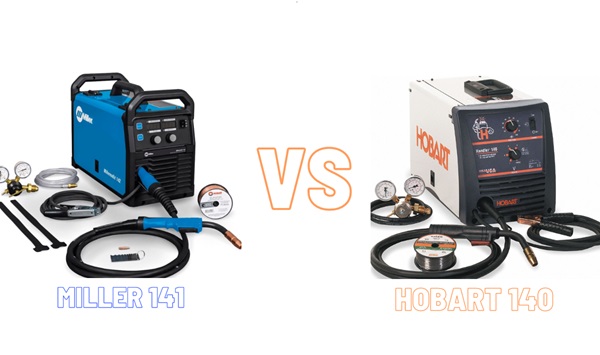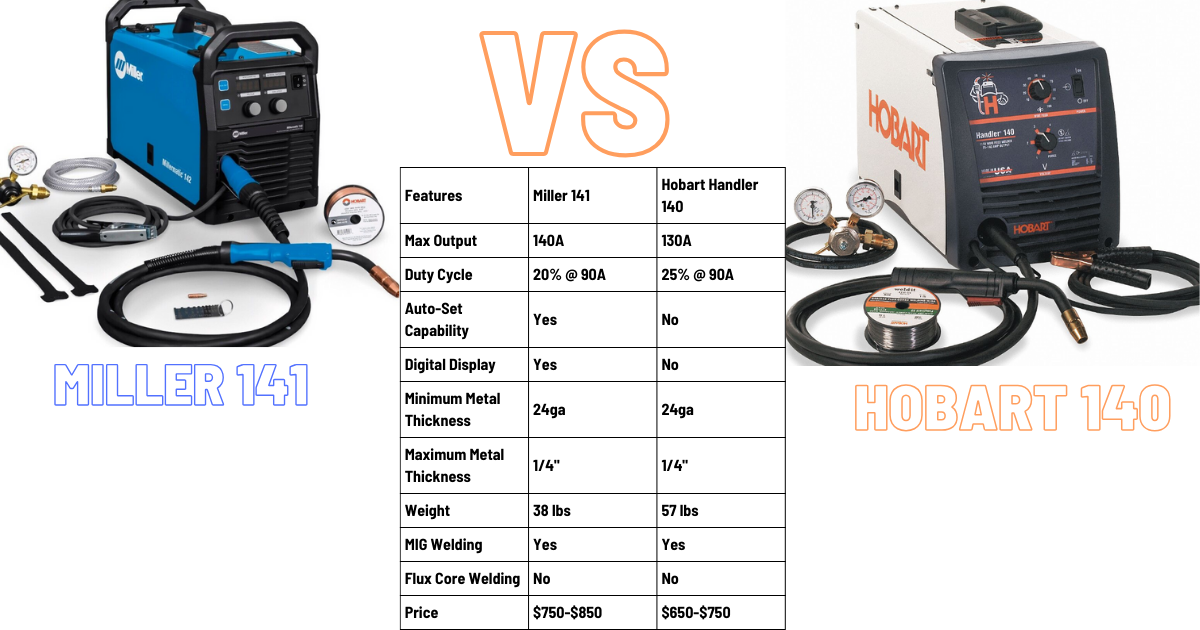If you’re in the market for an entry-level MIG welder, the Millermatic 141 and Hobart Handler 140 are two of the most popular choices. Both are compact, portable welders packed with great features for hobbyists and home garage DIYers. But how do you pick the right model for your needs?
This in-depth comparison examines all the key factors, specs and capabilities of the Miller 141 and Hobart 140 welders. Read on for a detailed breakdown to help you determine the best welder for your projects, experience level and budget.
Miller 141 vs Hobart 140 – Power and Performance

First, let’s look at the core power specs and general welding capabilities of each machine:
| Specs | Miller 141 | Hobart Handler 140 |
|---|---|---|
| Max Output | 140A | 130A |
| Duty Cycle | 20% @ 90A | 25% @ 90A |
| Metal Thickness | 24ga – 1/4in | 24ga – 1/4in |
| Welding Process | MIG (GMAW) | MIG (GMAW) |
The maximum output is 140A on the Miller 141, while the Hobart 140 maxes out at 130A. This gives the Miller a slight edge for welding thicker materials, but both can handle 24ga up to 1/4″ steel.
In terms of duty cycle, the Hobart 140 is rated at 25% at 90A. This means you can weld for 2.5 minutes straight at 90A before the welder needs to cool down to avoid overheating. The Miller 141 duty cycle is a bit lower at 20% at 90A (2 minutes welding time).
For general hobbyist and home use, both welders deliver very similar welding capabilities. The Hobart 140 gives you longer continuous weld times before overheating thanks to the higher 25% duty cycle. But the Miller 141 offers an extra 10A of power at max amperage.
Ease of Use
A big priority for beginner welders is having an intuitive, easy to operate machine. Both the Millermatic 141 and Hobart Handler 140 are designed for simplicity.
The basic controls are similar – two knobs to independently set wire speed and welding voltage. But the Miller 141 includes a few extra features that improve ease of use:
Auto-Set – Simply input the thickness of the metal you’re welding and the Miller 141 will automatically adjust voltage and wire speed to optimal settings. Takes the guesswork out of setup.
Digital Display – The Millermatic 141 features an easy to read screen that displays voltage and wire speed while you weld. The Hobart 140 relies on analog dials.
Overall, the auto-set function and digital display make accurate adjustments quicker and simpler on the Miller. For new welders still learning, these features provide valuable assistance dialing in optimal settings.
Portability
Another major consideration is portability and mobility. Many home garage welders need to move their welder around the shop or transport it for use on various DIY projects.
In this category, the Millermatic 141 really shines. It weighs just 38 pounds, making it incredibly lightweight and portable for a 140A welder. The Hobart Handler 140 tips the scales at a heftier 57 pounds.
Nearly 20 pounds lighter, the Miller 141 takes up less space on a workbench and is vastly easier to pack up and transport as needed. For any welder prioritizing portability, the Miller is hard to beat.
Cost and Value Comparison
With any major purchase, cost always needs to be weighed against overall value and benefit. Let’s break down the price comparison:
| Welder | Average Price | Price Range |
|---|---|---|
| Millermatic 141 | $800 | $750 – $850 |
| Hobart Handler 140 | $700 | $650 – $750 |
The Hobart 140 gives you an excellent welder for the money, typically priced around $650 to $750. To gain the advantages of the Miller 141 like the auto-set, digital display and lighter weight design, expect to spend $100 to $150 more.
Is the extra value worth the increased price for the Miller? For welders who can fit it into their budget, the innovative features and portable size justify the price premium. But the Hobart 140 remains a high performing, quality welder at a more budget-friendly cost.
Millermatic 141 vs Hobart Handler 140 – Feature Comparison
To recap, here is a detailed feature comparison of the Miller 141 up against the Hobart 140:
| Features | Miller 141 | Hobart Handler 140 |
|---|---|---|
| Max Output | 140A | 130A |
| Duty Cycle | 20% @ 90A | 25% @ 90A |
| Auto-Set Capability | Yes | No |
| Digital Display | Yes | No |
| Minimum Metal Thickness | 24ga | 24ga |
| Maximum Metal Thickness | 1/4″ | 1/4″ |
| Weight | 38 lbs | 57 lbs |
| MIG Welding | Yes | Yes |
| Flux Core Welding | No | No |
| Price | $750-$850 | $650-$750 |
Which One Should You Buy?
After looking closely at all the specs, capabilities and key factors, which welder is the better choice?
For hobbyists, home garage welders and DIYers who value advanced features, lightweight portability and don’t mind paying a little extra, the Millermatic 141 is a great option. It simplifies setup with auto-set, displays parameters digitally for accuracy, and is designed for easy transport at just 38 pounds.
If your top priority is keeping costs down without sacrificing power and performance, the Hobart Handler 140 gives you tremendous value. You still get a versatile, quality welder with great output for the price.
Overall, new and intermediate welders will benefit most from the Miller 141’s innovative ease of use additions. But the Hobart 140 remains a smart choice for anyone on a tight budget looking for a reliable 140A welder.
No matter which you choose, both the Millermatic 141 and Hobart Handler 140 are excellent MIG welders for home garages and hobby shops. Carefully assess your needs and budget to pick the model that’s right for your projects.

Leave a Reply